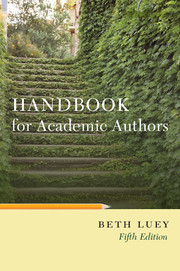Book contents
- Frontmatter
- Contents
- Illustrations
- Preface to the Fifth Edition
- Preface to the Fourth Edition
- Preface to the Third Edition
- Preface to the Second Edition
- Preface to the First Edition
- Chapter 1 The Publishing Partnership
- Chapter 2 Journal Articles
- Chapter 3 Revising a Dissertation
- Chapter 4 Finding a Publisher for the Scholarly Book
- Chapter 5 Working with Your Publisher
- Chapter 6 Multiauthor Books and Anthologies
- Chapter 7 Finding a Publisher for the College Textbook
- Chapter 8 Working with Your Textbook Publisher
- Chapter 9 Books for General Readers
- Chapter 10 The Mechanics of Authorship
- Chapter 11 Costs and Prices
- Chapter 12 Born Digital
- Bibliography
- Index
Chapter 8 - Working with Your Textbook Publisher
Published online by Cambridge University Press: 02 December 2010
- Frontmatter
- Contents
- Illustrations
- Preface to the Fifth Edition
- Preface to the Fourth Edition
- Preface to the Third Edition
- Preface to the Second Edition
- Preface to the First Edition
- Chapter 1 The Publishing Partnership
- Chapter 2 Journal Articles
- Chapter 3 Revising a Dissertation
- Chapter 4 Finding a Publisher for the Scholarly Book
- Chapter 5 Working with Your Publisher
- Chapter 6 Multiauthor Books and Anthologies
- Chapter 7 Finding a Publisher for the College Textbook
- Chapter 8 Working with Your Textbook Publisher
- Chapter 9 Books for General Readers
- Chapter 10 The Mechanics of Authorship
- Chapter 11 Costs and Prices
- Chapter 12 Born Digital
- Bibliography
- Index
Summary
…As we were leaving he hinted
That a student could hardly do less
Than see how the volumes were printed
At the time-honoured Clarendon Press.
So I went there with scholarly yearning,
And I gathered from kind Mr. Gell,
Some books were to stimulate learning,
And some were intended to sell.
Oxford Magazine, 1892Writing, reviewing, and revising a textbook manuscript are very different from the parallel processes in scholarly publishing. As noted in Chapter 7, the purpose and content of a textbook are not those of the scholarly monograph. Textbooks also differ in the level of difficulty, in format, and in the degree of illustration. And as I also noted earlier, textbooks must please your colleagues or they will not be used. A monograph presents a unique viewpoint. If it is well documented and convincingly written, it will be read (and sometimes appreciated) even by those who disagree with its conclusions and approach. But a textbook must try to be all things to all teachers, and this necessitates a different review process and the consideration of a new range of writing issues.
Writing a Textbook
A textbook must be credible and authoritative. The key element in conveying credibility is, of course, your competence to write the book. You must know your subject thoroughly. The basic sources in your field, as well as the current literature, must be at your fingertips. Let us assume, though, that you would not attempt to write about a subject you do not know.
- Type
- Chapter
- Information
- Handbook for Academic Authors , pp. 133 - 149Publisher: Cambridge University PressPrint publication year: 2009



